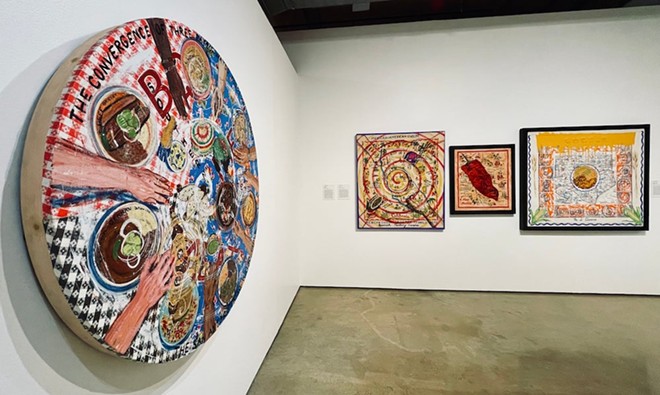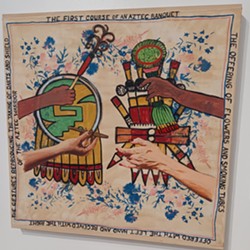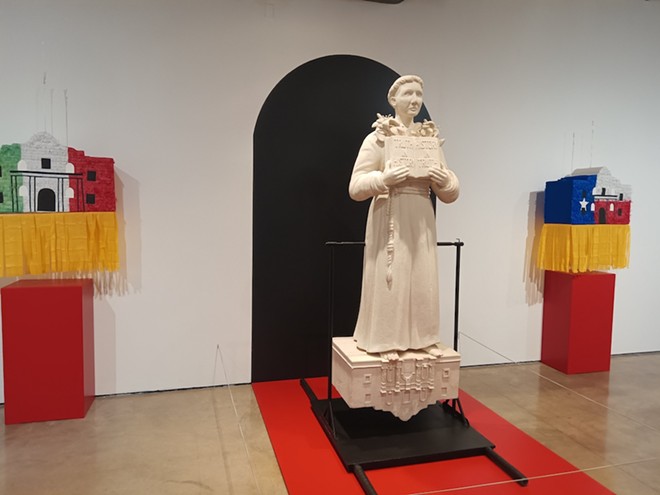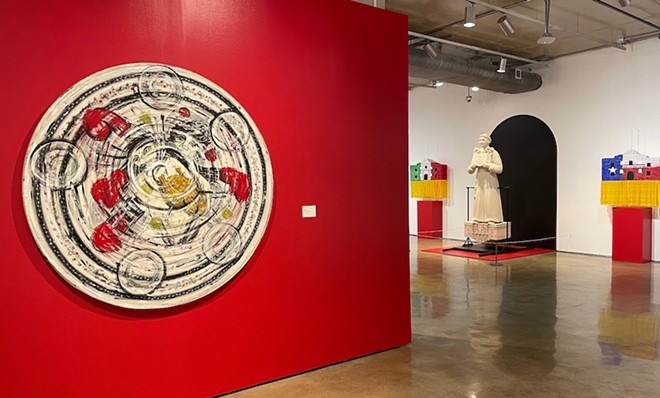
The show, curated by Ruben C. Cordova, runs through Feb. 9 and features more than 75 works that span the breadth of San Antonio-born Briseño’s decades-long career.
During that time, Briseño would go on to become an activist, food historian and “cultural adjuster.” He was one of the last members to join the seminal art collective Con Safo during the 1970s and was heavily influenced by artist Mel Casas.
Briseño also was the partner of San Antonio artist Angel Rodriguez Diaz, who died last year. The powerhouse couple often created highly political works concerned with the advancement and preservation of both LGBTQ+ rights and Latino culture.
“Together, they worked to make San Antonio a better and more beautiful place,” curator Cordova said.
Among the works in Centro de Artes’ exhibition are the artist’s first painting at age 17, several prints created while Briseño was part of Con Safo and a large sculpture of Saint Anthony once displayed in front of the Alamo during a performance piece.
At the heart of the exhibition, though, are Briseño’s works incorporating food.
Moctezuma’s Table
One of the highlights is Corn Tortilla Twin Towers, a model replica of the World Trade Center created from more than 300 corn tortillas and pigmented with red chilies. The work is an homage to “los hijos de maiz,” the many undocumented immigrants who Briseño believes worked as dishwashers and busboys at the World Trade Center and never returned home.
“Corn is thought to be the grain of sustenance,” Cordova said. “In fact, some people have theorized that it was the development of corn, and the calories it provided and nutritional value, that allowed for the rise of the great Mesoamerican civilizations, beginning with the Olmec.”
The Aztec emperor Moctezuma often dined from more than 300 dishes, according to Spanish accounts. Briseño was angered by 19th century ethnologist Lewis Henry Morgan who claimed that information was false. Morgan insisted that all Indigenous Americans only ate a communal stew cooked in a large kettle.
Briseño’s disapproval of the manner in which Mexican food was denigrated led him to create a series of works that treated all aspects of Mesoamerican food from cultivation to worldwide decimation.
“He wanted to show not only the importance and sophistication of food in pre-Columbian society but also how it was selectively bred and how it later impacted the world,” Cordova explained.
In the large-scale scale painting Tabasco, Briseño incorporates a variety of pop-art elements — the use of text, an emphasis on name brands and focus on mundane household items — as he depicts the label on a bottle of Tabasco hot sauce. The work protests the brand’s use of the word “pepper” instead of the word “chile,” a choice Briseño perceived as a denial of the sauce’s main ingredient and its Mexican origins.
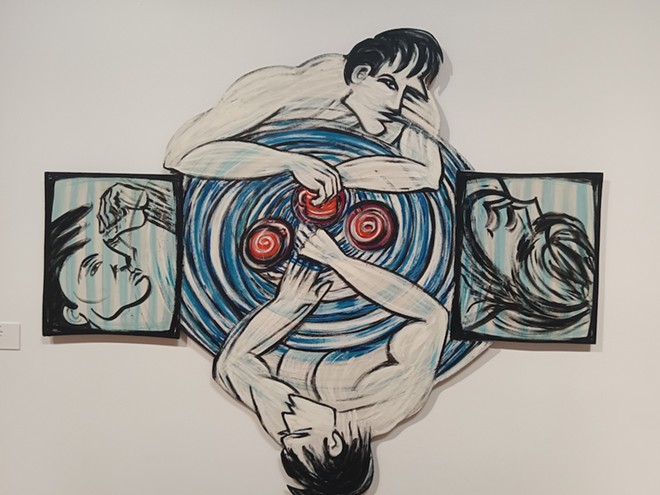
Tablescapes
Briseño grew up in a traditional household where family members ate around the dinner table and meals were a time for sharing and discussion. After leaving for college, he was shocked to see that students often ate in front of the TV.
“It gave him such a jolt that it became the engine for his Tablescapes series,” Cordova said. “He further imagined that there was going to be an increasing amount of devices and technology that were going to invade the table.”
As a result, works in the series depict TV remotes placed alongside spoons and forks and microwaves juxtaposed with television sets.
In Games People Play, Briseño shows two men who sit in front of each other but avoid each other’s gaze so they can focus on figures on monitors that could be either TVs or computer screens. Again, the artist is commenting on the distraction from interpersonal communication and alienation caused by modern technology.
“One of the big transitions came in the ’60s, when families were watching the evening news during dinnertime while the Vietnam War took place,” Cordova said. “That’s when there was this migration to the TV screen during what they called the first televised war. It really commanded attention.”
Works from Briseño’s Celestial Tablescapes series are displayed toward the back of the gallery and in a separate room. Many of the works in that series depict nude male and female figures. While a simple, nondescript warning sign at the entrance is easy to miss, it nonetheless marks immense progress by the city in displaying the nude figure.
The incorporation of the Celestial Tablescapes works certainly is a long way from the nationwide scandal that ensued when city officials chose to remove a work featuring nudity from its “XicanX: New Visions” exhibition in 2020.
For these reasons and more, it’s vital that we appreciate and celebrate the work of artists such as Briseño, whose work continues to push boundaries and question cultural norms.
Free, 10:30 a.m.-5 p.m. Wednesday through Friday, noon-5 p.m. Saturday and Sunday through Feb. 9, 2025. Centro de Artes Gallery, 101 S. Santa Rosa Ave., (210) 207-6960, sa.gov/arts.
Subscribe to SA Current newsletters.Follow us: Apple News | Google News | NewsBreak | Reddit | Instagram | Facebook | Twitter| Or sign up for our RSS Feed

